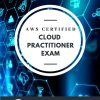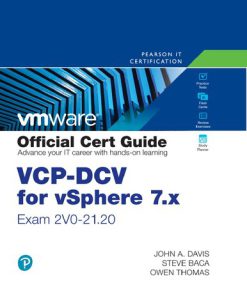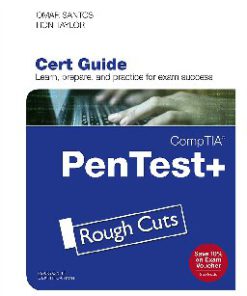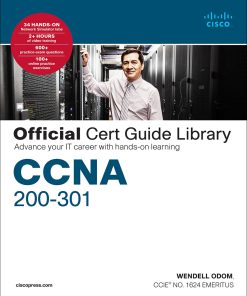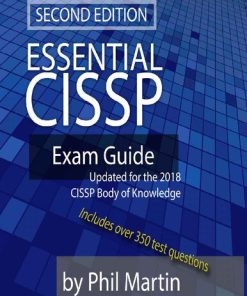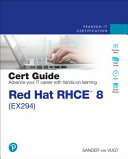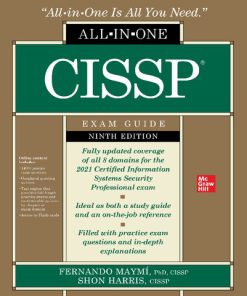CISSP Cert Guide Certification Guide 4th Edition by Robin Abernathy, Darren Hayes 0137507593 9780137507597
$50.00 Original price was: $50.00.$25.00Current price is: $25.00.
CISSP Cert Guide Certification Guide 4th Edition by Robin Abernathy, Darren Hayes – Ebook PDF Instant Download/Delivery: 0137507593, 9780137507597
Full download CISSP Cert Guide Certification Guide 4th Edition after payment

Product details:
ISBN 10: 0137507593
ISBN 13: 9780137507597
Author: Robin Abernathy; Darren R. Hayes
CISSP Cert Guide Certification Guide 4th Table of contents:
Chapter 1 Security and Risk Management
Security Terms
CIA
Confidentiality
Integrity
Availability
Auditing and Accounting
Non-repudiation
Default Security Posture
Defense in Depth
Abstraction
Data Hiding
Encryption
Security Governance Principles
Security Function Alignment
Organizational Strategies and Goals
Organizational Mission and Objectives
Business Case
Security Budget, Metrics, and Efficacy
Resources
Organizational Processes
Acquisitions and Divestitures
Governance Committees
Organizational Roles and Responsibilities
Board of Directors
Management
Audit Committee
Data Owner
Data Custodian
System Owner
System Administrator
Security Analyst
Application Owner
Supervisor
User
Auditor
Security Control Frameworks
ISO/IEC 27000 Series
Zachman Framework
The Open Group Architecture Framework (TOGAF)
Department of Defense Architecture Framework (DoDAF)
British Ministry of Defence Architecture Framework (MODAF)
Sherwood Applied Business Security Architecture (SABSA)
Control Objectives for Information and Related Technology (COBIT)
National Institute of Standards and Technology (NIST) Special Publication (SP) 800 Series
HITRUST CSF
CIS Critical Security Controls
Committee of Sponsoring Organizations (COSO) of the Treadway Commission Framework
Computer Crime Concepts
Operationally Critical Threat, Asset, and Vulnerability Evaluation (OCTAVE)
Information Technology Infrastructure Library (ITIL)
Six Sigma
Capability Maturity Model Integration (CMMI)
CCTA Risk Analysis and Management Method (CRAMM)
Top-Down Versus Bottom-Up Approach
Security Program Life Cycle
Due Care and Due Diligence
Compliance
Contractual, Legal, Industry Standards, and Regulatory Compliance
Privacy Requirements Compliance
Legal and Regulatory Issues
Computer-Assisted Crime
Computer-Targeted Crime
Incidental Computer Crime
Computer Prevalence Crime
Hackers Versus Crackers
Computer Crime Examples
Major Legal Systems
Civil Law
Common Law
Criminal Law
Civil/Tort Law
Administrative/Regulatory Law
Customary Law
Religious Law
Mixed Law
Licensing and Intellectual Property
Patent
Civil
Trade Secret
Trademark
Copyright
Software Piracy and Licensing Issues
Internal Protection
Digital Rights Managements (DRM)
Cyber Crimes and Data Breaches
Import/Export Controls
Trans-Border Data Flow
Privacy
Personally Identifiable Information (PII)
Laws and Regulations
Investigation Types
Operations/Administrative
Criminal
Regulatory
Industry Standards
eDiscovery
Professional Ethics
(ISC)2 Code of Ethics
Computer Ethics Institute
Internet Architecture Board
Organizational Code of Ethics
Security Documentation
Policies
Organizational Security Policy
System-Specific Security Policy
Issue-Specific Security Policy
Policy Categories
Processes
Procedures
Standards
Guidelines
Baselines
Business Continuity
Business Continuity and Disaster Recovery Concepts
Disruptions
Disasters
Disaster Recovery and the Disaster Recovery Plan (DRP)
Continuity Planning and the Business Continuity Plan (BCP)
Business Impact Analysis (BIA)
Contingency Plan
Availability
Reliability
Scope and Plan
Personnel Components
Scope
Business Contingency Planning
BIA Development
Identify Critical Processes and Resources
Identify Outage Impact and Estimate Downtime
Identify Resource Requirements
Identify Recovery Priorities
Implementation
Personnel Security Policies and Procedures
Candidate Screening and Hiring
Employment Agreements and Policies
Employee Onboarding and Offboarding Policies
Vendor, Consultant, and Contractor Agreements and Controls
Compliance Policy Requirements
Privacy Policy Requirements
Job Rotation
Separation of Duties
Risk Management Concepts
Asset and Asset Valuation
Vulnerability
Threat
Threat Agent
Exploit
Risk
Exposure
Countermeasure
Risk Appetite
Attack
Breach
Risk Management Policy
Risk Management Team
Risk Analysis Team
Risk Assessment
Information and Asset (Tangible/Intangible) Value and Costs
Identity Threats and Vulnerabilities
Risk Assessment/Analysis
Countermeasure (Safeguard) Selection
Inherent Risk Versus Residual Risk
Handling Risk and Risk Response
Implementation
Control Categories
Compensative
Corrective
Detective
Deterrent
Directive
Preventive
Recovery
Control Types
Administrative (Management)
Logical (Technical)
Physical
Controls Assessment, Monitoring, and Measurement
Reporting and Continuous Improvement
Risk Frameworks
NIST
ISO/IEC 27005:2018
Open Source Security Testing Methodology Manual (OSSTMM)
COSO’s Enterprise Risk Management (ERM) Integrated Framework
A Risk Management Standard by the Federation of European Risk Management Associations (FERMA)
Geographical Threats
Internal Versus External Threats
Natural Threats
Hurricanes/Tropical Storms
Tornadoes
Earthquakes
Floods
Volcanoes
System Threats
Electrical
Communications
Utilities
Human-Caused Threats
Explosions
Fire
Vandalism
Fraud
Theft
Collusion
Politically Motivated Threats
Strikes
Riots
Civil Disobedience
Terrorist Acts
Bombing
Threat Modeling
Threat Modeling Concepts
Threat Modeling Methodologies
STRIDE Model
Process for Attack Simulation and Threat Analysis (PASTA) Methodology
Trike Methodology
Visual, Agile, and Simple Threat (VAST) Model
NIST SP 800-154
Identifying Threats
Potential Attacks
Remediation Technologies and Processes
Security Risks in the Supply Chain
Risks Associated with Hardware, Software, and Services
Third-Party Assessment and Monitoring
Onsite Assessment
Document Exchange/Review
Process/Policy Review
Other Third-Party Governance Issues
Minimum Service-Level and Security Requirements
Service-Level Requirements
Security Education, Training, and Awareness
Levels Required
Methods and Techniques
Periodic Content Reviews
Review All Key Topics
Complete the Tables and Lists from Memory
Define Key Terms
Answers and Explanations
Chapter 2 Asset Security
Asset Security Concepts
Asset and Data Policies
Data Quality
Data Documentation and Organization
Identify and Classify Information and Assets
Data and Asset Classification
Sensitivity and Criticality
PII
PHI
Proprietary Data
Private Sector Data Classifications
Military and Government Data Classifications
Information and Asset Handling Requirements
Marking, Labeling, and Storing
Destruction
Provision Resources Securely
Asset Inventory and Asset Management
Data Life Cycle
Databases
DBMS Architecture and Models
Database Interface Languages
Data Warehouses and Data Mining
Database Maintenance
Database Threats
Database Views
Database Locks
Polyinstantiation
Database ACID Test
Roles and Responsibilities
Data Owner
Data Controller
Data Custodian
System Owners
System Custodians
Business/Mission Owners
Data Processors
Data Users and Subjects
Data Collection and Limitation
Data Location
Data Maintenance
Data Retention
Data Remanence and Destruction
Data Audit
Asset Retention
Data Security Controls
Data Security
Data States
Data at Rest
Data in Transit
Data in Use
Data Access and Sharing
Data Storage and Archiving
Baselines
Scoping and Tailoring
Standards Selection
Data Protection Methods
Cryptography
Digital Rights Management (DRM)
Data Loss Prevention (DLP)
Cloud Access Security Broker (CASB)
Review All Key Topics
Define Key Terms
Answers and Explanations
Chapter 3 Security Architecture and Engineering
Engineering Processes Using Secure Design Principles
Objects and Subjects
Closed Versus Open Systems
Threat Modeling
Least Privilege
Defense in Depth
Secure Defaults
Fail Securely
Separation of Duties (SoD)
Keep It Simple
Zero Trust
Privacy by Design
Trust but Verify
Shared Responsibility
Security Model Concepts
Confidentiality, Integrity, and Availability
Confinement
Bounds
Isolation
Security Modes
Dedicated Security Mode
System High Security Mode
Compartmented Security Mode
Multilevel Security Mode
Assurance and Trust
Security Model Types
State Machine Models
Multilevel Lattice Models
Matrix-Based Models
Noninterference Models
Information Flow Models
Take-Grant Model
Security Models
Bell-LaPadula Model
Biba Model
Clark-Wilson Integrity Model
Lipner Model
Brewer-Nash (Chinese Wall) Model
Graham-Denning Model
Harrison-Ruzzo-Ullman Model
Goguen-Meseguer Model
Sutherland Model
System Architecture Steps
ISO/IEC 42010:2011
Computing Platforms
Mainframe/Thin Clients
Distributed Systems
Middleware
Embedded Systems
Mobile Computing
Virtual Computing
Security Services
Boundary Control Services
Access Control Services
Integrity Services
Cryptography Services
Auditing and Monitoring Services
System Components
CPU
Memory and Storage
Input/Output Devices
Input/Output Structures
Firmware
Operating Systems
Memory Management
System Security Evaluation Models
TCSEC
Rainbow Series
ITSEC
Common Criteria
Security Implementation Standards
ISO/IEC 27001
ISO/IEC 27002
Payment Card Industry Data Security Standard (PCI DSS)
Controls and Countermeasures
Certification and Accreditation
Control Selection Based on Systems Security Requirements
Security Capabilities of Information Systems
Memory Protection
Trusted Platform Module
Interfaces
Fault Tolerance
Policy Mechanisms
Separation of Privilege
Accountability
Encryption/Decryption
Data Mining Warehouse
Security Architecture Maintenance
Vulnerabilities of Security Architectures, Designs, and Solution Elements
Client-Based Systems
Server-Based Systems
Data Flow Control
Database Systems
Inference
Aggregation
Contamination
Data Mining Warehouse
Cryptographic Systems
Industrial Control Systems
Cloud-Based Systems
Large-Scale Parallel Data Systems
Distributed Systems
Grid Computing
Peer-to-Peer Computing
Internet of Things
Cryptography History
IoT Examples
Methods of Securing IoT Devices
NIST Framework for Cyber-Physical Systems
Microservices
Containerization
Serverless Systems
High-Performance Computing Systems
Edge Computing Systems
Virtualized Systems
Vulnerabilities in Web-Based Systems
Maintenance Hooks
Time-of-Check/Time-of-Use Attacks
Web-Based Attacks
XML
SAML
OWASP
Vulnerabilities in Mobile Systems
Device Security
Application Security
Mobile Device Concerns
NIST SP 800-164
Vulnerabilities in Embedded Systems
Cryptographic Solutions
Cryptography Concepts
Cryptography History
Julius Caesar and the Caesar Cipher
Vigenere Cipher
Kerckhoffs’s Principle
World War II Enigma
Lucifer by IBM
Cryptosystem Features
Authentication
Confidentiality
Integrity
Authorization
Non-repudiation
NIST SP 800-175A and B
Cryptographic Mathematics
Boolean
Logical Operations (And, Or, Not, Exclusive Or)
Modulo Function
One-Way Function
Nonce
Split Knowledge
Cryptographic Life Cycle
Key Management
Algorithm Selection
Cryptographic Types
Running Key and Concealment Ciphers
Substitution Ciphers
One-Time Pads
Steganography
Transposition Ciphers
Symmetric Algorithms
Stream-Based Ciphers
Block Ciphers
Initialization Vectors (IVs)
Asymmetric Algorithms
Hybrid Ciphers
Elliptic Curves
Quantum Cryptography
Symmetric Algorithms
DES and 3DES
DES Modes
3DES and Modes
AES
IDEA
Skipjack
Blowfish
Twofish
RC4/RC5/RC6/RC7
CAST
Asymmetric Algorithms
Diffie-Hellman
RSA
El Gamal
ECC
Knapsack
Zero-Knowledge Proof
Public Key Infrastructure and Digital Certificates
Certificate Authority and Registration Authority
Certificates
Certificate Life Cycle
Enrollment
Verification
Revocation
Renewal and Modification
Certificate Revocation List
OCSP
PKI Steps
Cross-Certification
Key Management Practices
Message Integrity
Hashing
One-Way Hash
MD2/MD4/MD5/MD6
SHA/SHA-2/SHA-3
HAVAL
RIPEMD-160
Tiger
Message Authentication Code
HMAC
CBC-MAC
CMAC
Salting
Digital Signatures and Non-repudiation
DSS
Non-repudiation
Applied Cryptography
Link Encryption Versus End-to-End Encryption
Email Security
Internet Security
Cryptanalytic Attacks
Ciphertext-Only Attack
Known Plaintext Attack
Chosen Plaintext Attack
Chosen Ciphertext Attack
Social Engineering
Brute Force
Differential Cryptanalysis
Linear Cryptanalysis
Algebraic Attack
Frequency Analysis
Birthday Attack
Dictionary Attack
Replay Attack
Analytic Attack
Statistical Attack
Factoring Attack
Reverse Engineering
Meet-in-the-Middle Attack
Ransomware Attack
Side-Channel Attack
Implementation Attack
Fault Injection
Timing Attack
Pass-the-Hash Attack
Digital Rights Management
Document DRM
Music DRM
Movie DRM
Video Game DRM
E-book DRM
Site and Facility Design
Layered Defense Model
CPTED
Natural Access Control
Natural Surveillance
Natural Territorials Reinforcement
Physical Security Plan
Deter Criminal Activity
Delay Intruders
Detect Intruders
Assess Situation
Respond to Intrusions and Disruptions
Facility Selection Issues
Visibility
Surrounding Area and External Entities
Accessibility
Construction
Internal Compartments
Computer and Equipment Rooms
Site and Facility Security Controls
Doors
Door Lock Types
Turnstiles and Mantraps
Locks
Biometrics
Type of Glass Used for Entrances
Visitor Control
Wiring Closets/Intermediate Distribution Facilities
Restricted and Work Areas
Secure Data Center
Restricted Work Area
Server Room
Media Storage Facilities
Evidence Storage
Environmental Security and Issues
Fire Protection
Power Supply
HVAC
Water Leakage and Flooding
Environmental Alarms
Equipment Physical Security
Corporate Procedures
Safes, Vaults, and Locking
Review All Key Topics
Complete the Tables and Lists from Memory
Define Key Terms
Answers and Explanations
Chapter 4 Communication and Network Security
Secure Network Design Principles
OSI Model
Application Layer
Presentation Layer
Session Layer
Transport Layer
Network Layer
Data Link Layer
Physical Layer
TCP/IP Model
Application Layer
Transport Layer
Internet Layer
Link Layer
Encapsulation and De-encapsulation
IP Networking
Common TCP/UDP Ports
Logical and Physical Addressing
IPv4
IP Classes
Public Versus Private IP Addresses
NAT
MAC Addressing
Network Transmission
Analog Versus Digital
Asynchronous Versus Synchronous
Broadband Versus Baseband
Unicast, Multicast, and Broadcast
Wired Versus Wireless
IPv6
NIST SP 800-119
IPv6 Major Features
IPv4 Versus IPv6 Threat Comparison
IPv6 Addressing
Shorthand for Writing IPv6 Addresses
IPv6 Address Types
IPv6 Address Scope
Network Types
Local-Area Network (LAN)
Intranet
Extranet
MAN
WAN
WLAN
SAN
CAN
PAN
Protocols and Services
ARP/RARP
DHCP/BOOTP
DNS
FTP, FTPS, SFTP, and TFTP
HTTP, HTTPS, and S-HTTP
ICMP
IGMP
IMAP
LDAP
LDP
NAT
NetBIOS
NFS
PAT
POP
CIFS/SMB
SMTP
SNMP
SSL/TLS
Multilayer Protocols
Converged Protocols
FCoE
MPLS
VoIP
iSCSI
Wireless Networks
FHSS, DSSS, OFDM, VOFDM, FDMA, TDMA, CDMA, OFDMA, and GSM
802.11 Techniques
Cellular or Mobile Wireless Techniques
5G
Satellites
WLAN Structure
Access Point
Service Set Identifier (SSID)
Infrastructure Mode Versus Ad Hoc Mode
WLAN Standards
802.11
802.11a
802.11b
802.11g
802.11n (Wi-Fi 4)
802.11ac (Wi-Fi 5)
802.11ax (Wi-Fi 6)
802.11be (Wi-Fi 7)
Bluetooth
Infrared
Near Field Communication (NFC)
Zigbee
WLAN Security
Open System Authentication
Shared Key Authentication
WEP
WPA
WPA2
Personal Versus Enterprise
WPA3
802.1X
SSID Broadcast
MAC Filter
Wireless Site Surveys
Antenna Placement and Power Levels
Antenna Types
Communications Cryptography
Link Encryption
End-to-End Encryption
Email Security
PGP
MIME and S/MIME
Quantum Cryptography
Internet Security
Remote Access
HTTP, HTTPS, and S-HTTP
Secure Electronic Transaction (SET)
Cookies
SSH
IPsec
Secure Network Components
Hardware
Network Devices
Network Routing
Transmission Media
Cabling
Network Topologies
Network Technologies
WAN Technologies
Network Access Control Devices
Quarantine/Remediation
Firewalls/Proxies
Endpoint Security
Content-Distribution Networks
Secure Communication Channels
Voice
Multimedia Collaboration
Remote Meeting Technology
Instant Messaging
Remote Access
Remote Connection Technologies
VPN Screen Scraper
Virtual Application/Desktop
Telecommuting/Teleworking
Data Communications
Virtualized Networks
SDN
Virtual SAN
Guest Operating Systems
Federated Identity with a Third-Party
Network Attacks
Cabling
Noise
Attenuation
Crosstalk
Eavesdropping
Network Component Attacks
Non-Blind Spoofing
Blind Spoofing
Man-in-the-Middle Attack
MAC Flooding Attack
802.1Q and Inter-Switch Link Protocol (ISL) Tagging Attack
Double-Encapsulated 802.1Q/Nested VLAN Attack
ARP Attack
ICMP Attacks
Ping of Death
Smurf
Fraggle
ICMP Redirect
Ping Scanning
Traceroute Exploitation
DNS Attacks
DNS Cache Poisoning
DoS
DDoS
DNSSEC
URL Hiding
Domain Grabbing
Cybersquatting
Email Attacks
Email Spoofing
Spear Phishing
Whaling
Spam
Wireless Attacks
Wardriving
Warchalking
Remote Attacks
Other Attacks
SYN ACK Attacks
Session Hijacking
Port Scanning
Teardrop
IP Address Spoofing
Zero-Day
Ransomware
Review All Key Topics
Define Key Terms
Answers and Explanations
Chapter 5 Identity and Access Management (IAM)
Access Control Process
Identify Resources
Identify Users
Identify the Relationships Between Resources and Users
Physical and Logical Access to Assets
Access Control Administration
Centralized
Decentralized
Information
Systems
Devices
Facilities
Applications
Identification and Authentication Concepts
NIST SP 800-63
Five Factors for Authentication
Knowledge Factors
Ownership Factors
Characteristic Factors
Location Factors
Time Factors
Single-Factor Versus Multifactor Authentication
Device Authentication
Identification and Authentication Implementation
Separation of Duties
Least Privilege/Need-to-Know
Default to No Access
Directory Services
Single Sign-on
Kerberos
SESAME
OpenID Connect (OIDC)/Open Authorization (Oauth)
Security Assertion Markup Language (SAML)
Federated Identity Management (IdM)
Security Domains
Session Management
Registration, Proof, and Establishment of Identity
Credential Management Systems
Remote Authentication Dial-In User Service (RADIUS)/Terminal Access Controller Access Control System
Accountability
Auditing and Reporting
Just-In-Time (JIT)
Identity as a Service (IDaaS) Implementation
Third-Party Identity Services Integration
Authorization Mechanisms
Permissions, Rights, and Privileges
Access Control Models
Discretionary Access Control
Mandatory Access Control
Role-Based Access Control
Rule-Based Access Control
Attribute-Based Access Control
Content-Dependent Versus Context-Dependent
Risk-Based Access Control
Access Control Matrix
Access Control Policies
Provisioning Life Cycle
Provisioning
Identity and Account Management
User, System, and Service Account Access Review
Account Transfers
Account Revocation
Role Definition
Privilege Escalation
Access Control Threats
Password Threats
Dictionary Attack
Brute-Force Attack
Birthday Attack
Rainbow Table Attack
Sniffer Attack
Social Engineering Threats
Phishing/Pharming
Shoulder Surfing
Identity Theft
Dumpster Diving
DoS/DDoS
Buffer Overflow
Mobile Code
Malicious Software
Spoofing
Sniffing and Eavesdropping
Emanating
Backdoor/Trapdoor
Access Aggregation
Advanced Persistent Threat
Prevent or Mitigate Access Control Threats
Review All Key Topics
Define Key Terms
Answers and Explanations
Chapter 6 Security Assessment and Testing
Design and Validate Assessment and Testing Strategies
Security Testing
Security Assessments
Red Team versus Blue Team
Security Auditing
Internal, External, and Third-party Security Assessment, Testing, and Auditing
Conduct Security Control Testing
Vulnerability Assessment
Network Discovery Scan
Network Vulnerability Scan
Web Application Vulnerability Scan
Penetration Testing
Log Reviews
NIST SP 800-92
Synthetic Transactions
Code Review and Testing
Code Review Process
Static Testing
Dynamic Testing
Fuzz Testing
Misuse Case Testing
Test Coverage Analysis
Interface Testing
Collect Security Process Data
NIST SP 800-137
Account Management
Management Review and Approval
Key Performance and Risk Indicators
Backup Verification Data
Training and Awareness
Disaster Recovery and Business Continuity
Analyze Test Outputs and Generate a Report
Conduct or Facilitate Security Audits
Review All Key Topics
Define Key Terms
Answers and Explanations
Chapter 7 Security Operations
Investigations
Forensic and Digital Investigations
Identify Evidence
Preserve and Collect Evidence
Examine and Analyze Evidence
Present Findings
Decide
Forensic Procedures
Reporting and Documentation
IOCE/SWGDE and NIST
Crime Scene
MOM
Chain of Custody
Interviewing
Investigative Techniques
Evidence Collection and Handling
Five Rules of Evidence
Types of Evidence
Surveillance, Search, and Seizure
Media Analysis
Software Analysis
Network Analysis
Hardware/Embedded Device Analysis
Digital Forensic Tools, Tactics, and Procedures
Logging and Monitoring Activities
Audit and Review
Log Types
Audit Types
Intrusion Detection and Prevention
Security Information and Event Management (SIEM)
Continuous Monitoring
Egress Monitoring
Log Management
Threat Intelligence
User and Entity Behavior Analytics (UEBA)
Configuration and Change Management
Resource Provisioning
Asset Inventory and Management
Baselining
Automation
Security Operations Concepts
Need to Know/Least Privilege
Managing Accounts, Groups, and Roles
Separation of Duties and Responsibilities
Privilege Account Management
Job Rotation and Mandatory Vacation
Two-Person Control
Sensitive Information Procedures
Record Retention
Information Life Cycle
Service-Level Agreements
Resource Protection
Protecting Tangible and Intangible Assets
Facilities
Hardware
Software
Information Assets
Asset Management
Redundancy and Fault Tolerance
Backup and Recovery Systems
Identity and Access Management
Media Management
Media History
Media Labeling and Storage
Sanitizing and Disposing of Media
Network and Resource Management
Incident Management
Event Versus Incident
Incident Response Team and Incident Investigations
Rules of Engagement, Authorization, and Scope
Incident Response Procedures
Incident Response Management
Detect
Respond
Mitigate
Report
Recover
Remediate
Review and Lessons Learned
Detective and Preventive Measures
IDS/IPS
Firewalls
Whitelisting/Blacklisting
Third-Party Security Services
Sandboxing
Honeypots/Honeynets
Anti-malware/Antivirus
Clipping Levels
Deviations from Standards
Unusual or Unexplained Events
Unscheduled Reboots
Unauthorized Disclosure
Trusted Recovery
Trusted Paths
Input/Output Controls
System Hardening
Vulnerability Management Systems
Machine Learning and Artificial Intelligence (AI)-Based Tools
Patch and Vulnerability Management
Recovery Strategies
Create Recovery Strategies
Categorize Asset Recovery Priorities
Business Process Recovery
Supply and Technology Recovery
User Environment Recovery
Data Recovery
Training Personnel
Backup Storage Strategies
Recovery and Multiple Site Strategies
Hot Site
Cold Site
Warm Site
Tertiary Site
Reciprocal Agreements
Redundant Sites
Redundant Systems, Facilities, and Power
Fault-Tolerance Technologies
Insurance
Data Backup
Fire Detection and Suppression
High Availability
Quality of Service
System Resilience
Disaster Recovery
Response
Personnel
Damage Assessment Team
Legal Team
Media Relations Team
Recovery Team
Relocation Team
Restoration Team
Salvage Team
Security Team
Communications
Assessment
Restoration
Training and Awareness
Lessons Learned
Testing Disaster Recovery Plans
Read-Through Test
Checklist Test
Table-Top Exercise
Structured Walk-Through Test
Simulation Test
Parallel Test
Full-Interruption Test
Functional Drill
Evacuation Drill
Business Continuity Planning and Exercises
Physical Security
Perimeter Security Controls
Gates and Fences
Perimeter Intrusion Detection
Lighting
Patrol Force
Access Control
Building and Internal Security Controls
Personnel Safety and Security
Duress
Travel
Monitoring
Emergency Management
Security Training and Awareness
Review All Key Topics
Define Key Terms
Answers and Explanations
Chapter 8 Software Development Security
Software Development Concepts
Machine Languages
Assembly Languages and Assemblers
High-Level Languages, Compilers, and Interpreters
Object-Oriented Programming
Polymorphism
Polyinstantiation
Encapsulation
Cohesion
Coupling
Data Structures
Distributed Object-Oriented Systems
CORBA
COM and DCOM
OLE
Java
SOA
Mobile Code
Java Applets
ActiveX
NIST SP 800-163
Security in the System and Software Development Life Cycle
System Development Life Cycle
Initiate
Acquire/Develop
Implement
Operate/Maintain
Dispose
Software Development Life Cycle
Plan/Initiate Project
Gather Requirements
Design
Develop
Test/Validate
Release/Maintenance
Certify/Accredit
Change Management and Configuration Management/Replacement
DevSecOps
Static Application Security Testing (SAST) and Dynamic Application Security Testing (DAST)
Security Orchestration and Automated Response (SOAR)
Software Development Methods and Maturity Models
Build and Fix Model
Waterfall Model
V-Shaped Model
Prototyping
Modified Prototype Model (MPM)
Incremental Model
Spiral Model
Agile Model
Continuous Integration and Continuous Delivery (CI/CD)
Rapid Application Development (RAD)
Joint Analysis Development (JAD)
Cleanroom Model
Structured Programming Development Model
Exploratory Model
Computer-Aided Software Engineering (CASE)
Component-Based Development
CMMI
ISO 9001:2015/90003:2014
IDEAL Model
Operation and Maintenance
Integrated Product Team
Security Controls in Development
Software Development Security Best Practices
WASC
OWASP
BSI
ISO/IEC 27000
Software Environment Security
Source Code Analysis Tools
Code Repository Security
Software Threats
Malware
Malware Protection
Scanning Types
Security Policies
Software Protection Mechanisms
Assess Software Security Effectiveness
Auditing and Logging
Risk Analysis and Mitigation
Regression and Acceptance Testing
Security Impact of Acquired Software
Secure Coding Guidelines and Standards
Security Weaknesses and Vulnerabilities at the Source Code Level
Buffer Overflow
Escalation of Privileges
Backdoor
Rogue Programmers
Covert Channel
Object Reuse
Mobile Code
Time of Check/Time of Use (TOC/TOU)
Security of Application Programming Interfaces
Secure Coding Practices
Validate Input
Heed Compiler Warnings
Design for Security Policies
Implement Default Deny
Adhere to the Principle of Least Privilege, and Practice Defense in Depth
Sanitize Data Prior to Transmission to Other Systems
Review All Key Topics
Define Key Terms
Answers and Explanations
Chapter 9 Final Preparation
Tools for Final Preparation
Pearson Test Prep Practice Test Engine and Questions on the Website
Accessing the Pearson Test Prep Practice Test Software Online
Accessing the Pearson Test Prep Practice Test Software Offline
Customizing Your Exams
Updating Your Exams
Premium Edition
Memory Tables
Chapter-Ending Review Tools
Suggested Plan for Final Review/Study
People also search for CISSP Cert Guide Certification Guide 4th :
cissp certification study guide pdf
cissp cert guide 4th edition
cissp cert guide
cissp certification study guide
Tags:
Robin Abernathy,Darren Hayes,CISSP Cert Guide
You may also like…
Computers - Computer Certification & Training
Computers - Computer Certification & Training
CompTIA PenTest+ PT0-001 Cert Guide (Certification Guide) 1st Edition Omar Santos
Reference - School Guides & Test Preparation
CompTIA Project PK0 005 Cert Guide, 2nd Edition by Robin, Ann 0138074429 9780138074425
Computers - Computer Certification & Training
CCNA 200 301 Official Cert Guide Library 1st Edition Wendell Odom
Computers - Computer Certification & Training
Essential CISSP Exam Guide Updated for the 2018 CISSP Body of Knowledge 2nd Edition Phil Martin
Computers - Computer Certification & Training
Computers - Computer Certification & Training
Red Hat RHCE 8 (EX294) Cert Guide (Certification Guide) 1st Edition Van Vugt
Computers - Computer Certification & Training
CISSP All-in-One Exam Guide, 9th Edition by Maymi 9781260467369 1260467368
Uncategorized


